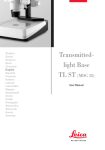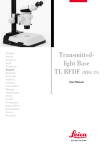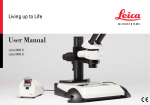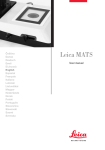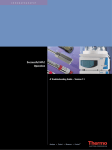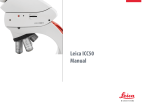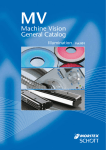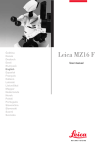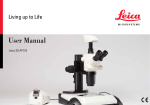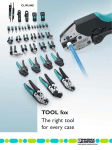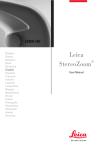Download Leica swing-arm stands
Transcript
Leica swing-arm stands User manual ESD swing-arm stand 1 2 3 4 5 6 7 8 1 2 3 4 5 6 7 8 9 10 11 Connection for focusing arms/drives Clamping screw for connection Horizontal arm Rotary knob for fixing the cantilever Cross-member Safety ring Clamping screw for fixing the safety ring Rotary knob for fixing the height adjustment Vertical column Baseplate Dampening feet 9 10 11 Fig. 1 2 User manual Leica swing-arm stands Standard swing-arm stand 1 2 3 4 5 6 7 8 9 1 2 3 4 5 6 7 8 9 10 11 12 Connection for focusing arms/drives Clamping lever for connection Horizontal arm Rotary knob for fixing the cantilever Cross-member Rotary knob for fixing the height adjustment Plug for limiting the swiveling range Safety ring Clamping lever for fixing the safety ring Vertical column Baseplate Dampening feet 10 11 12 Fig. 2 User manual Leica swing-arm stands 3 Large swing-arm stand 1 2 3 4 5 6 7 8 1 2 3 4 5 6 7 8 9 10 11 12 13 14 Connection for focusing arms/drives Clamping lever for connection Horizontal arm Rotary knob for fixing the height adjustment Cross-member Rotary knob for fixing the cantilever Screw for setting the rheostat Crank for height adjustment Rack on vertical column Ring for limiting the swiveling range Clamping lever for fixing the ring Clamping lever for fixing the vertical column Baseplate Dampening feet 9 10 11 12 13 14 Fig. 1 4 User manual Leica swing-arm stands User manual Leica swing-arm stands 5 6 User manual Leica swing-arm stands Dear User, Thank you for your choosing our products. We hope that you will enjoy the quality and performance of Leica Microsystems products. In developing our instruments, we place great value on simple, self-explanatory operation. Nevertheless, please take the time and read the operating instructions so that you know the benefits and possibilities your Leica swing-arm stand offers and can utilize them to your advantage. Should you ever have any questions, please consult your local Leica representative. You will find the address of the closest local representative as well as valuable information about products and services from Leica Microsystems on our homepage at www.leica-microsystems.com We are gladly at your service. Customer service is a big thing with us. Not only before the sale, but afterwards as well. Leica Microsystems (Switzerland) Ltd. Stereo & Macroscope Systems www.stereomicroscopy.com The user manual These operating instructions are available in 20 additional languages on the interactive CD-ROM. User manuals and updates are available for you to download from our web site at www.stereomicroscopy.com. The present operating instructions contain descriptions of the safety instructions, setup, handling and accessories of the ESD, standard and large swing-arm stands. User manual Leica swing-arm stands 7 Contents Page Introduction Overview of ESD swing-arm stand . . . . . . . . . . . . . . . . . . . . . . . . . 2 Overview of standard swing-arm stand . . . . . . . . . . . . . . . . . . . . . 2 Overview of large swing-arm stand . . . . . . . . . . . . . . . . . . . . . . . . 4 Contents . . . . . . . . . . . . . . . . . . . . . . . . . . . . . . . . . . . . . . . . . . . . . . . .8 Safety concept . . . . . . . . . . . . . . . . . . . . . . . . . . . . . . . . . . . . . . . . . .9 General safety instructions . . . . . . . . . . . . . . . . . . . . . . . . . . . .10-11 General safety instructions of swing-arm stand . . . . . . . . . .12-13 Assembly ESD and standard swing-arm stands . . . . . . . . . . . . . . . . . . .14-16 Large swing-arm stand . . . . . . . . . . . . . . . . . . . . . . . . . . . . . . . 18-19 Focusing arms and drives . . . . . . . . . . . . . . . . . . . . . . . . . . . . .20-21 Microscope carrier/stereomicroscope . . . . . . . . . . . . . . . . . . . .22 Operation ESD swing-arm stand . . . . . . . . . . . . . . . . . . . . . . . . . . . . . . . . 24-25 Standard swing-arm stand . . . . . . . . . . . . . . . . . . . . . . . . . . . . 26-27 Large swing-arm stand . . . . . . . . . . . . . . . . . . . . . . . . . . . . . . . 28-29 Leaving the workplace . . . . . . . . . . . . . . . . . . . . . . . . . . . . . . . . . . .30 Transport of swing-arm stands . . . . . . . . . . . . . . . . . . . . . . . . . . . .30 Starting position . . . . . . . . . . . . . . . . . . . . . . . . . . . . . . . . . . . . . . . .31 Notes about horizontal swinging . . . . . . . . . . . . . . . . . . . . . . .32-33 Table of permissible equipment weights . . . . . . . . . . . . . . . . .34-35 List of typical equipment weights . . . . . . . . . . . . . . . . . . . . . . .36-37 Appendix Technical data . . . . . . . . . . . . . . . . . . . . . . . . . . . . . . . . . . . . . . . . . .38 Dimensions . . . . . . . . . . . . . . . . . . . . . . . . . . . . . . . . . . . . . . . . . 39-44 Part numbers . . . . . . . . . . . . . . . . . . . . . . . . . . . . . . . . . . . . . . . . . . .45 Assembly diagram of swing-arm stands . . . . . . . . . . . . . . . . .46-47 8 User manual Leica swing-arm stands Safety concept General notes Before startup, read the operating instructions and safety instructions. Intended use The Leica swing-arm stands are mechanical devices that help in expanding the range of your stereomicroscopes and macroscopes and to move them across large work specimens. Illuminations and various accessory modules, e.g. for photography, TV, second-observer tube and more, complement the equipment. Improper use • If the instrument is used in any other way than described in these instructions, it may result in injuries to persons or damages to property. • Never disassemble mechanical parts if not specifically instructed to in this manual. Place of use Use in ESD-protected rooms • The Leica swing-arm stands are intended primarily for use in closed rooms. • If the swing-arm stand is used outdoors, it must be protected against dust and moisture. Electrically operated illuminations must not be used outdoors. The ESD standard and large swing-arm stands consist of an ESD-discharging material so that they counteract the buildup of electrostatic charges. User manual Leica swing-arm stands 9 General safety instructions Service work Responsibilities of the person(s) in charge of instrument Repair work must only be performed by Leica-trained service technicians. Only original Leica spare parts may be used. • Ensure that the operating personnel has read and understood this manual and particularly the safety instructions. • Ensure that only authorized and trained personnel operates, services and maintains the Leica swing-arm stands. Workplaces with swing-arm stands facilitate and improve working with large specimens, but they also impose demands on concentration ability, viewing and muscular support on part of the user. Depending on the duration of uninterrupted work, asthenopia and musculoskeletal problems may occur. For this reason, appropriate measures for reduction of the workload must be taken: • optimal arrangement of workplace, work assignments and work flow (changing tasks frequently). • thorough training of the personnel, giving consideration to ergonomic and organization aspects. The ergonomic optics concept the of Leica stereomicroscopes and the design of the swing-arm stands aim to limit the strain on the user to the lowest possible level. 10 User manual Leica swing-arm stands Integration in third-party products When installing Leica products into third-party products, note the following: The manufacturer of the complete system or its dealer is responsible for following all applicable safety instructions, laws and guidelines. Legal requirements Adhere to general and local regulations relating to accident prevention and environmental protection. Disposal The product must be disposed of in accordance with locally applicable laws and regulations. Symbol used in the operating instructions Safety instructions This symbol indicates especially important information that, if not observed, • can cause hazards to personnel • can lead to functional disturbances and damaged instruments Important information This symbol indicates additional information or explanations that intend to provide clarity. Action 왘 This symbol refers to actions described in the text that are to be carried out. Explanatory notes • This symbol indicates additional notes and explanations provided in the text. User manual Leica swing-arm stands 11 General safety instructions of swing-arm stands The use of your Leica swing-arm stand requires adhering to the safety instructions in this manual to prevent injuries to yourself or damages to your Leica stereomicroscope equipment and work environment. Setup of swing-arm stands Use of flange and stage clamp The baseplate of the swing-arm stands consists of heavy metal parts. If it is used improperly, it can cause injuries or damages to the work environment or your Leica stereomicroscope equipment due to its weight. Flange and stage clamp are accessories for mounting the vertical column at your workplace. Since they support the entire stereomicroscope equipment, special care must be paid when attaching them. • Perform the setup of the swing-arm stand with two persons so that one person can always secure the parts to be assembled. (Fig. 1) • Use a slipfree underlay (e.g. a rubber mat) for the assembly of the vertical column on the baseplate so that the baseplate cannot slide or slip. • Always use a flat even surface for the baseplate. • To fasten the stage clamp (Fig. 4.1), use a sufficiently thick (21-70mm) and solid worktop. • Check the correct seat of the stage clamp at regular intervals and retighten, if necessary. • Ensure that technical personnel selects the correct type of screws and screw lengths for the respective support during the assembly of the flange. The safety ring (for ESD and standard horizontal arms) protects the horizontal arm from inadvertently falling down. • Reposition the retaining ring (Fig. 2.2) after every change in position at the horizontal arm and tighten the clamping screw or lever (Fig. 2.1). The retaining washer (Fig. 3.1) allows for freely swinging the focusing drive across the object, even if the plug is mounted from below. It also protects your stereomicroscope from inadvertently falling out if you want to open the clamping lever (Fig. 3.2) during your work. The clamping lever or screw at the focusing arm (Fig. 3.3) must be tightened before inserting the stereomicroscope in the carrier. 12 During the work Leica swing-arm stands are optimized to provide maximum flexibility with minimum weight and space requirements. To be able to use the full performance of your swing-arm stand, the following steps must be observed: • Before changing the stereomicroscope, bring your stand to the starting position. (See page 31) • Before you continue to work with a modified equipment, observe the notes about horizontal swinging. (Page 32) Transport of swing-arm stands Please read the notes on p. 30 concerning the safe disassembly and transport of the swing-arm stand. User manual Leica swing-arm stands 1 2 Fig. 1 Fig. 2 1 2 3 Fig. 3 Fig. 4 Fig. 1 Assembly of vertical column to the base plate with two persons Fig. 2 ESD horizontal arm with cross-member and safety ring on column 470/35 Fig. 3 Standard horizontal arm with focusing arm mounted from the top 1 Retaining washer 2 Clamping lever at horizontal arm 3 Hexagon-head screw for fixing the tilt at the focusing arm 1 Clamping screw at safety ring 2 Safety ring Fig. 4 Stage clamp for ESD and standard horizontal arm User manual Leica swing-arm stands 13 Assembly of ESD and standard swing-arm stands Corresponding to their function, the swing-arm stands consist of solid, heavy metal parts. While unpacking, ensure that nobody can be injured by falling or tipping parts. The assembly of baseplate and vertical column must always be performed by two persons. Additional safety instructions on page 12 must be observed. Vertical column ➜ baseplate Two persons are needed for the assembly of the small and midsize baseplates to the vertical column 470/35 to prevent the plate from tipping over and causing any damages! Vertical column ➜ flange 왘 Slide the threaded bolt from underneath through the correct bore hole. 왘 Place the serrated lock washer on the bolt. 왘 Bolt the vertical column and flange together using the Allen key. 왘 Place the baseplate on a slipfree surface. 왘 Slide the threaded bolt from underneath through the baseplate. The flange (Fig. 4) must be fastened at the workplace by qualified personnel and regularly checked for firm seat. 왘 Place the serrated lock washer on the bolt (Fig. 2.1). 왘 While one person secures the base, the second person tightens the vertical column (Fig. 1)! Vertical column ➜ stage clamp 왘 Slide the threaded bolt from underneath through the correct bore hole. 왘 Place the serrated lock washer on the bolt. 왘 Screw the vertical column and stage clamp together. (Fig. 3) 왘 Fasten the stage clamp together with the vertical column to the desired position on your worktop. Ensure that the worktop (thickness: 2170mm) is suitable to provide sufficient support for the swing-arm stand including the equipment. Check the firm seat of the stage clamp at the worktop at regular intervals. 14 User manual Leica swing-arm stands The four screws for fastening the flange are not part of the standard delivery since length and type of screw must be adapted to the supporting surface. 1 Fig. 1 Fig. 2 Fig. 3 Fig. 4 Fig. 1 Assembly of vertical column to the base plate with two persons Fig. 2 Baseplate with hexagon-head screw and serrated lock washer for the assembly of the ESD and standard horizontal arms Fig. 3 Assembly of the vertical column 470/35 to the stage clamp 1 Serrated lock washer Fig. 4 Flange for permanent assembly of the vertical column 470/35 User manual Leica swing-arm stands 15 Safety ring ➜ vertical column 왘 Slide the safety ring over the column (Fig. 1.3). 왘 Tighten the clamping screw (ESD) or the clamping lever (standard) (Fig. 1.2). 1 Horizontal arm ➜ vertical column 왘 Open the rotary knob for the height adjustment (Fig. 1.1). 왘 Carefully place the horizontal arm on the vertical column until it sits on the safety ring. 왘 Align the horizontal arm parallel to the long side of the baseplate. 왘 Retighten the rotary knob (Fig. 1.1) for the height adjustment. 2 3 Fig. 1 Alignment of clamping levers • At the standard and large horizontal arms, the clamping levers can be turned to any position after tightening to provide you with the largest possible freedom of movement: 왘 Tighten the respective clamping lever. 왘 Pull the clamping lever out in its axis (Fig. 2). 왘 Turn the lever to the desired position and release it. Fig. 2 Assembly of focusing arms and drives To assemble the focusing arms and drives, please continue on page 20. Fig. 1 ESD horizontal arm with cross-member and safety ring on vertical column 470/35 1 Rotary knob for fixing the cantilever 2 Clamping screw at safety ring 3 Safety ring Fig. 2 Clamping lever at safety ring of the standard horizontal arm 16 User manual Leica swing-arm stands User manual Leica swing-arm stands 17 Assembly of the large swing-arm stand Vertical column ➜ baseplate Fig. 1 Assembly of vertical column 560/57 or 800/57 onto the large baseplate Two persons are needed for the assembly of the large baseplate to the vertical column 560/57 and 800/57 to prevent the column from tipping over and causing any damages! 1 The rack is positioned in the direction of the cutout of the base 2 The vertical column is fastened with four hexagon-head screws 왘 Position the vertical column with the rack (Fig. 1.1) towards the cutout of the base so that the four bore holes in the base align with the four threaded holes on the plate. 왘 While one person secures the vertical column, the second person tightens the column with the four hexagon-head screws. (Fig.1.2) Fig. 2 Hexagon-head screw at the head of the vertical column 560/57 or 800/57 Fig. 3 The cross-member at the large horizontal arm is carefully placed on the vertical column. Horizontal arm ➜ vertical column 왘 Open the rotary knob for the height adjustment (p. 4, Fig. 1.4). 왘 Remove the screw at the head of the vertical column (Fig. 2.1). 왘 Carefully place the horizontal arm on the vertical column until it sits on the rack (Fig. 3). 왘 Carefully turn the crank several turns until the worm in the cross-member is completely meshed with the rack and the upper end of the rack reappears. 왘 Reinsert the previously removed screw at the head of the vertical column (Fig. 2.1). 왘 Retighten the rotary knob for the height adjustment (p. 4, Fig. 1.4). Use of clamping levers To use the clamping levers, please continue on page 16. Assembly of focusing arms and drives To assemble the focusing arms and drives, please continue on page 20. 18 User manual Leica swing-arm stands 1 2 Fig. 1 1 Fig. 2 Fig. 3 User manual Leica swing-arm stands 19 Assembly of focusing arms and drives Focusing arm ➜ horizontal arm 왘 Ensure that the horizontal arm is in the starting position. (See p. 31). 1 2 왘 Fasten all levers and screws. 왘 Open the lever or the screw at the focusing arm connection of the horizontal arm. 왘 Remove the retaining washer from the connect- ing plug of the focusing arm. 왘 Insert the plug (Fig. 1.2) into the socket (Fig. 1.1) at the horizontal arm. 왘 Close the clamping lever or screw again at the 3 horizontal arm. • A special case is the combination of carrier rod (10 447 259) with focusing arm (10 446 344): 왘 Remove the retaining washer from the carrier rod. 왘 Open the safety screw at the focusing arm. 왘 Slide the focusing arm onto the column. 왘 Close the safety screw. 왘 Fasten the retaining washer again. 왘 Close the clamping lever or screw again at the horizontal arm. Fig. 1 1 Assembly of focusing arm plug from the bottom • On principle, the plug of the focusing arms can be inserted at the horizontal arm from the top, the bottom or the front. • If the plug is attached to the horizontal arm from the bottom, you must use the retaining washer (Fig. 2.1): 왘 Screw the retaining washer with the corresponding hexagon-head screw into the threaded hole of the plug at the focusing arm (Fig.2.1). Fig. 2 Fig. 1 Placing the focusing arm on the horizontal arm 1 Socket at the horizontal arm 2 Plug of the focusing arm 3 Clamping lever for fixing the focusing arm Fig. 2 Focusing arm with plug mounted from the bottom 1 Retaining washer 20 User manual Leica swing-arm stands Focusing drive ➜ horizontal arm 2 왘 Ensure that the horizontal arm is in the starting position (see p. 31). 1 2 왘 Fasten all levers and screws. 왘 Open the clamping lever at the focusing drive connection (Fig. 1.1). 왘 Remove the retaining washer from the connecting plug of the focusing drive. 왘 Insert the plug (Fig. 1.2) into the socket at the horizontal arm. 1 왘 Close the clamping lever again (Fig. 1.1). Fig. 1 Fig. 1 Focusing drive at the large horizontal arm 1 Clamping lever at horizontal arm 2 Plug of the focusing drive User manual Leica swing-arm stands 21 Assembly of microscope carrier and stereomicroscope Microscope carrier ➜ focusing drive 왘 Remove the safety screw from the front side of the focusing drive. 왘 Position the microscope carrier so that the two 1 positioning plugs (Fig. 1.1) lock into the corresponding recesses at the microscope carrier. 왘 Insert the safety screw into the bore hole in the microscope carrier and retighten it with the Allen key. (Fig. 1.2) 2 Stereomicroscope ➜ optics carrier 왘 Check and fix all levers and screws at the swing-arm stand and the focusing drive/arm before inserting the stereomicroscope into the microscope carrier. 왘 Open the screw (Fig. 2.1) at the ring of the microscope carrier. 왘 Use both hands and carefully insert the stereomicroscope into the microscope carrier. (Fig. 2) 왘 Retighten the screw (Fig. 2.1) at the microscope carrier. Fig. 1 Additional notes about the assembly of microscope carriers and swing-arm stands can be found in the operating instructions M2-105-0en. Fig. 2 They also contain additional adapters and accessories for attaching illumination to the Leica swing-arm stands (see the example on page 37). Fig. 1 Placing the optics carrier on the horizontal arm 1 1 Connecting plug at the focusing drive 2 Hexagon-head screw for fixing the carrier Fig. 2 Inserting the stereomicroscope into the optics carrier 1 Screw for fixing the stereomicroscope 22 User manual Leica swing-arm stands User manual Leica swing-arm stands 23 Operation of swing-arm stands The following operating notes show the correct use of your swing-arm stand. Ensure that only personnel who has read and understood these operating instructions and particularly the safety instructions is working with a Leica swing-arm stand. In addition, check the correct seat of all levers and screws before every operating step. ESD swing-arm stand 왘 Retighten the rotary knob for the height Leica swing-arm stands are optimized for stability and safe use. Nevertheless, the wrong combination of equipment, cantilever and swinging angle can cause the stand to tip over. For this reason, it is absolutely necessary to read the safety instructions on page 12-13. Changing the cantilever 왘 Close all levers and screws. 왘 Open the rotary knob for the cantilever adjustment. (Fig. 1.1) 왘 Pull the horizontal arm out of the cross-member adjustment (Fig. 1.2). 왘 Reposition the safety ring (Fig. 1.4) until it is below the cross-member. Changing the equipment 왘 Bring the horizontal arm into the starting position (see p. 31) before changing the stereomicroscope or adding additional equipment to the swing-arm stand. 왘 Ensure that the stand supports the modified equipment. Notes about equipment weight and permissible total weights can be found on pages 32 to 37. to the required cantilever. 왘 Close the rotary knob at the cross-member. Lateral swinging of the equipment Changing the working height • Reducing the working height: 왘 Open the clamping screw (Fig. 1.3) at the safety ring (Fig. 1.4) and fix it to the desired working height. 왘 Open the rotary knob for the height adjustment (Fig. 1.2) and lower the horizontal arm to the desired height. Before you swing the stereomicroscope across your specimen, it is absolutely necessary to reposition the safety ring up to the cross-member and tighten it. Otherwise, the horizontal arm could fall down if the rotary knob is loosened (Fig. 1.2) and cause injuries or damages to equipment and specimens. 왘 Reposition the safety ring (Fig. 1.3) up to the cross-member and fix it in place. • Increasing the working height: 왘 Hold the horizontal arm with one hand. 왘 Open the rotary knob for the height adjustment. (Fig. 1.2) 왘 Push the horizontal arm up until the desired working height is reached. 24 왘 Open the rotary knob for the height adjustment (Fig. 1.1) at the cross-member. 왘 Swing your equipment into the desired position. 왘 Fix the height adjustment again. User manual Leica swing-arm stands 1 2 3 4 Fig. 1 Fig. 1 Leica S6 at the ESD horizontal arm with safety ring on vertical column 470/35 1 2 3 4 Rotary knob for fixing the cantilever Rotary knob for fixing the height adjustment Clamping screw for fixing the safety ring Safety ring User manual Leica swing-arm stands 25 Standard swing-arm stand Swinging and changing the cantilever • Swinging and changing the cantilever work similar to the description of the ESD horizontal arm. (See p. 24) Limiting the cantilever The maximum extension for the horizontal arm can be adjusted using the limiting screw. This is particularly useful to • conveniently reposition the equipment • prevent the system from tilting due to excessive equipment 왘 Bring the stand to its starting position. Limiting the swiveling range By using the special safety ring, you can limit the swiveling range of the horizontal arm to a 90° section. This function is particularly useful to • conveniently reposition the equipment with the limitation • remain within a certain swiveling range during your work (See page 31). 왘 Open the lever of the cantilever adjustment at the cross-member. 왘 Move the stereomicroscope to the desired extension. 왘 Reposition the adjustable stop (Fig. 1.2) up to the cross-member (Fig. 1.1). To be able to use this function, the plug (Fig. 1.4) at the safety ring (Fig. 1.5) must point upward. If this is not the case, the following steps are to be performed: 왘 Open the screw at the microscope carrier (Fig. 1.6). 왘 Remove the stereomicroscope. 왘 Open the rotary knob to fix the height adjustment (Fig. 1.3). 왘 Remove the horizontal arm including cross-member from the vertical column. 왘 Remove the safety ring (Fig. 1.5) from the vertical column. 왘 Position it on the vertical column with the plug pointing upward. 왘 Retighten the clamping screw at the safety ring (Fig. 1.5). 왘 Position the horizontal arm on the vertical column so that the plug at the safety ring fits into the cutout at the cross-member (Fig. 1.1). 왘 Fasten all rotary knobs at the cross-member. 26 User manual Leica swing-arm stands 12 3 4 5 6 Fig. 1 MS5 with coarse/fine focusing drive, lamp L2, double gooseneck, lamp holder for vertical column 470/35, standard swing-arm stand and midsize baseplate 1 2 3 4 5 6 Cross-member Adjustable stop Rotary knob for fixing the height adjustment Plug for limiting the swiveling range Safety ring Screw for fixing the optics carrier User manual Leica swing-arm stands 27 Large swing-arm stand Limiting the cantilever Changing the working height The maximum extension for the horizontal arm can be adjusted using the adjustable stop. The procedure is identical to the standard horizontal arm described on page 26. 왘 Close the rotary knob to fix the cantilever (Fig. 1.2). 왘 Open the rotary knob to fix the height adjustment at the cross-member (Fig. 1.1). 왘 Use the crank (Fig. 1.4) to move the system to the desired working height. 왘 Close the rotary knob again to fix the height adjustment (Fig. 1.1) The rheostat of the crank can be adjusted continuously using the supplied Allen key. This is necessary depending upon the desired force expenditure and weight of the equipment. 왘 Adjust the hexagon-head screw with the supplied key using quarter turns. (Fig. 1.3) • Tightening the screw clockwise increases the rheostat, loosening the screw counterclockwise reduces it. Never force the crank; otherwise, it may damage the rack or pinion. If it is very difficult to turn, check the following items: • Is the upper screw at the cross-member closed? If so, open it. • Is the hexagon-head screw at the crank tightened too much? If so, open it in increments. Changing the cantilever 왘 Close the rotary knob to fix the height adjustment (Fig. 1.1) 왘 Open the rotary knob to fix the cantilever (Fig. 1.2). 왘 Pull the horizontal arm out of the cross-member to the intended cantilever. 왘 Close the rotary knob to fix the cantilever (Fig. 1.2). 28 Swinging the horizontal arm The lateral swinging is enabled via the lever at the base of the vertical column: 왘 Close the two rotary knobs at the cross-member (Fig. 1.1 and 1.2). 왘 Open the clamping lever at the base of the vertical column. (Fig. 1.8) 왘 Rotate the stereomicroscope to the desired position. 왘 Close the clamping lever again. Limiting the swiveling range The swiveling range can also be limited at the large swing-arm stand to a freely selectable 90° sector. This function is performed by the ring at the base of the vertical column (Fig. 1.7): 왘 Open the clamping lever for the lateral swiveling limitation. (Fig. 1.6) 왘 Swing the stereomicroscope to the desired starting position as described above. 왘 Turn the ring (Fig. 1.7) up to one of the two stops. 왘 Close the clamping lever again. (Fig. 1.6) 왘 Leave the clamping lever open if you do not want to limit the swiveling range. The ring at the base of the vertical column (Fig. 1.7) must be fixed with the clamping lever so that it rests on the base (Fig. 1.9). Other assembly positions can damage the rack (Fig. 1.5) at the vertical column. User manual Leica swing-arm stands 1 2 3 4 5 6 7 8 9 Fig. 1 Fig. 1 MZ16 with Leica digital camera DFC300, coarse/fine focusing drive and large swing-arm stand 1 2 3 4 5 6 7 8 9 Rotary knob for fixing the height adjustment Rotary knob for fixing the cantilever Hex bit for adjusting the rheostat Crank for height adjustment Rack Clamping lever at the ring Ring at the base of the vertical column Clamping lever for fixing the vertical column Base of vertical column User manual Leica swing-arm stands 29 Leaving the workplace Protect other persons and your workplace against injuries or damages by securing your swing-arm stand before leaving the workplace: 왘 Return the swing-arm stand to the starting position (see p. 31). 왘 Fix all rotary knobs, clamping levers and screws to prevent any inadvertent movement of the swing-arm stand. Transport of swing-arm stands Leica swing-arm stands consist of heavy metal parts. If you intend to disassemble a stand at one workplace and move it to another workplace, please observe the following notes: Fig. 1 Fig. 1 Large baseplate with recessed grip 왘 Always transport the baseplate with mounted vertical column using two persons. 왘 Remove the stereomicroscope from the focusing drive/arm. 왘 Remove the horizontal arm including cross-member from the vertical column. 왘 The large baseplate features a recessed grip at one side that facilitates the transport. (Fig. 1) 왘 For transport over longer distances use a suit- able transport tool, such as a trolley. 30 User manual Leica swing-arm stands Starting position The following operating instructions can be used to determine whether the total weight of your stereomicroscope equipment is suitable for the intended cantilever and the swiveling range. These instructions must be followed and you must ensure that all personnel working with Leica swing-arm stands have read and understood these instructions. The starting position prevents damages from a tilting stand. The swing-arm stand must be brought to the starting position (Fig. 2) before you: • remove your stereomicroscope from the microscope carrier. • change accessories such as illumination or ErgoModules. • leave your workplace. 왘 Align the horizontal arm parallel to the long side of the baseplate. (Fig. 1) 왘 Retract the cantilever of the horizontal arm up to the cross-member. (Fig. 2) 왘 Ensure that all rotary knobs and clamping Fig. 1 levers or screws are fixed. Fig. 2 Fig. 1 Large horizontal arm aligned parallel to the long side of the baseplate Fig. 2 Large horizontal arm in starting position User manual Leica swing-arm stands 31 Notes about horizontal swinging Leica swing-arm stands are optimized for maximum range and stability. Nevertheless, the wrong combination of weight, cantilever and swinging angle can cause the stand to tip over. Selecting a safe swinging angle Examples for a typical application • The maximum permissible carrying load of your Leica swing-arm stand can be found in the corresponding table on page 34/35. • Starting with the zero position (Fig. 1.1), you can swing up to ±30° with the maximum carrying load. (Fig. 1) • For swinging angles >30° (Fig. 2), you must reduce either the weight or the cantilever at the stand. (Fig. 2) • A list of typical equipment weights can be found on page 36/37. The following example demonstrates how you can determine whether the planned combination of stereomicroscope, equipment and swing-arm stand is permissible: 왘 Before you continue working at the swing-arm stand with a modified equipment, you must carefully test the combination of intended cantilever and required swinging angle. • You want to use a standard horizontal arm with midsize base and inclinable focusing drive (10 447 256). • The table on page 34 shows that this combination allows for a maximum carrying load of 5.2kg in the zero position (Fig. 1.1). • You intend to use the following stereomicroscope equipment with this swing-arm stand: Leica MZ6 10 445 614 10 445 619 10 447 160 10 422 563 Leica MZ6 optics carrier Inclined binocular tube 45° 2 eyepieces 10x/21B, adjustable Objective achromat 0.5x, M-series This combination has a total weight of 1.8kg (list on page 36) and, therefore, can be used without problems in the range of ±30° at full cantilever! Fig. 1 Optimum swiveling range of the horizontal arm with maximum carrying load Fig. 2 Swiveling range in which cantilever and swinging angle must be carefully matched to the selected carrying load 32 User manual Leica swing-arm stands 1.1 Fig. 1 Fig. 2 User manual Leica swing-arm stands 33 Table of permissible equipment weights The following table provides information about the permissible carrying load dependent upon the horizontal arm, vertical column, baseplate and focusing arm or drive used. The maximum value applies to the respective swing-arm stand in the starting position (page 29). Horizontal arm with column 10 447 097 with 10 447 008 10 447 098 with 10 447 008 Focusing arm / focusing drive Baseplate 34 10 447 260 10 446 436 10 447 254/ 10 447 255 3.2kg 6.6kg 3.2kg 6.6kg 10 447259 & 10 446 344 3.6kg 8kg 3.6kg 4.6kg 10 447 256 X X 2kg 5.2kg 10 447 257 X X X 4.6kg 10 447 258 X X X X User manual Leica swing-arm stands 10 447 260 10 446 436 Horizontal arm with column 10 447 099 with 10 447 014 10 447 099 with 10 447 230 Focusing arm / focusing drive Baseplate 10 446 437 10 446 437 10 447 254/ 10 447 255 14kg 13kg 10 447259 & 10 446 344 14.5kg 13.5kg 10 447 256 13.5kg 12.5kg 10 447 257 11kg 11kg 10 447 258 11kg 10.5kg User manual Leica swing-arm stands 35 List of typical equipment weights The following listing provides an overview of the total weight of different typical types of equipment. Together with the table on page 34/35, it provides you with an estimate of whether the required swinging angle and the cantilever are compatible with the intended equipment. Leica S8 APO 10 446 298 Leica S8 APO StereoZoom 10 446 261 Video objective 0.63x 10 446 337 Objective apochromate 2.0x 12 730 044 DFC 480, including cable 10 447 131 2 eyepieces 10x/23 Total weight of outfit 2.9kg Leica S6 E 10 446 294 Leica S6 E StereoZoom 10 447 130 Eyepiece 10x/23 10 447 131 Eyepiece 10x/23, 10 446 323 ErgoLens® 0.6x-0.75x Total weight 1.7kg Leica MZ6 10 445 614 Leica MZ6 optics carrier 10 445 619 Inclined binocular tube 45° 10 447 160 2 eyepieces 10x/21B, adjustable 10 422 563 Objective achromat 0.5x, M-series Total weight 1.8kg Leica MZ75 10 446 371 Leica MZ75, optics carrier 10 446 275 Objective plan 1.0x, M-series 10 445 822 ErgoTube® 10°-50° 10 447 160 2 eyepieces 10x/21B, adjustable 10 446 309 Leica photo tube HD F 10 446 261 Video/photo objective 0.63x 12 730 044 DFC480 Total weight 4.8kg 36 Leica MZ95 10 446 272 Leica MZ95 optics carrier 10 446 275 Objective plan, 1.0x, M-series 10 445 924 Trinocular tube, M-series 10 447 160 2 eyepieces 10x/21B, adjustable 10 446 261 Video/photo objective 0.63x 12 730 044 DFC 480 30 120 201 Ringlight RL-66/750 Total weight 4.6kg Leica MZ125 10 446 370 Leica MZ125 optics carrier 10 447 160 2 eyepieces 10x/21B, adjustable 10 445 819 Objective plan 1.0x, M-series, 10 445 822 ErgoTube® with variable angle 10°-50° Total weight 3.7kg Leica MZ125 10 446 370 Leica MZ125 optics carrier 10 445 924 Trinocular tube, M-series 10 447 160 2 eyepieces 10x/21B, adjustable 10 445 819 Objective plan 1.0x, M-series, 10 446 123 ErgoWedge® 5-25° 10 446 261 Video/photo objective 0.63x 12 730 018 DC500 30 120 201 Ringlight RL-66/750 Total weight 5.2kg Leica MZ16 10 447 102 Leica MZ16 optics carrier with zoom 10 447 160 2 eyepieces 10x/21B, adjustable 10 447 157 Objective planapo 1.0x, M-series, WD=55mm 10 445 924 Trinocular tube, M-series 10 446 261 Video/photo objective 0.63x 12 730 044 DFC480 30 120 201 Ringlight RL-66/750 Total weight 5.7kg User manual Leica swing-arm stands Leica MZ16 A 10 447 103 Leica MZ16 A optics carrier 10 447 160 2 eyepieces 10x/21B, adjustable 10 445 822 ErgoTube® 10°-50° 10 446 309 Docu Tube HD V 10 447 075 Objective plan 0.8x LWD, M-series 10 446 261 Video/photo objective 0.63x 12 730 044 DFC480 30 120 201 Ringlight RL-66/750 Total weight 6.9kg Leica MZ16 FA 10 447 063 Leica MZ16 FA optics carrier 11 504 069 Lamp housing 10 447 160 2 eyepieces 10x/21B, adjustable 10 445 924 Trinocular tube, M-series 10 447 157 Objective planapo 1.0x, M-series, WD=55m 10 446 261 Video/photo objective 0.63x 12 730 044 DFC480 Total weight 9.2kg User manual Leica swing-arm stands 37 Technical data Large horizontal arm Type Max. cantilever: Max. carrying load: Standard horizontal arm Type Max. cantilever: Max. carrying load: ESD horizontal arm Type Max. cantilever: Max. carrying load: Vertical columns Vertical column 800/57 Vertical column 560/57 Vertical column 470/35 Baseplates Large baseplate Midsize baseplate Small baseplate 38 Horizontal swing arm for Leica stereomicroscopes and macroscopes; 360° swinging angle with optional 90° sector limitation Adjustable stop to limit the cantilever Height adjustment via rack 560mm 20kg (without focusing arm or drive) Horizontal swing arm for Leica stereomicroscopes and macroscopes; 360° swinging angle with optional 90° sector limitation Adjustable stop to limit the cantilever 476mm 13.2kg (without focusing arm or drive, with midsize baseplate) Horizontal swing arm for Leica stereomicroscopes and macroscopes; 360° swinging angle 452mm 6.6kg (without focusing arm or drive; with small baseplate) Vertical column for large horizontal arm Height: 800mm, diameter: 57mm Anodized aluminum; rack for height adjustment; Clamping lever for fixing horizontal swinging Clamping lever for fixing swinging range Vertical column for large horizontal arm Height: 560mm, diameter: 57mm Anodized aluminum; Rack for height adjustment Clamping lever for fixing horizontal swinging Clamping lever for fixing swinging range Vertical column for ESD/standard horizontal arm Height: 470mm, diameter: 35mm Chrome-plated steel Baseplate for large horizontal arm WxHxD: 400x300x28.5mm Weight: 20kg Baseplate for standard and ESD horizontal arm WxHxD: 330x220x33.5mm Weight: 17kg Baseplate for standard and ESD horizontal arm WxHxD: 260x220x33.5mm Weight: 13.5kg User manual Leica swing-arm stands Dimensions Large horizontal arm User manual Leica swing-arm stands 39 Standard horizontal arm 40 User manual Leica swing-arm stands ESD horizontal arm User manual Leica swing-arm stands 41 Vertical column 800/57 Vertical column 560/57 Vertical column 470/35 42 User manual Leica swing-arm stands Flange Stage clamp User manual Leica swing-arm stands 43 Large, midsize and small baseplates 44 User manual Leica swing-arm stands Part numbers with short descriptions 10 447 097 10 447 098 10 447 008 10 447 260 10 446 436 10 447 006 10 447 007 ESD horizontal arm Standard horizontal arm Vertical column 470/35mm Baseplate, small Baseplate, midsize Flange Table clamp 10 447 254 10 447 255 10 447 259 10 446 344 Focusing drive, inclinable, M series Focusing drive, inclinable, S series / Z series Carrier rod, inclinable, ∅ 25mm Focusing arm, for columns with ∅ 25mm 10 447 099 10 447 014 10 447 230 10 446 437 Horizontal arm, large Vertical column 560/57mm Vertical column 800/57mm Baseplate, large 10 447 256 10 447 257 10 447 258 10 447 196 10 446 394 10 445 617 10 447 114 10 447 062 Focusing drive, inclinable Coarse/fine focusing drive, inclinable Motorized focus, inclinable, 300mm Microscope carrier for Z series Microscope carrier for S-series / Z-series Microscope carrier for MS5 – MZ95 Microscope carrier for MZ125 – MZ16 A Microscope carrier AX for MZ125 – MZ16 A User manual Leica swing-arm stands 45 Assembly diagram of swing-arm stands 10 447 098 10 447 097 10 447 259 10 447 255 for S-Series / Z-Series (A,Y) 10 447 254 for M-Series 10 446 344 for S-Series / Z-Series (A,Y) 10 447 008 10 447 006 10 447 260 10 447 007 10 446 436 46 User manual Leica swing-arm stands 10 447 099 10 447 258 10 447 257 10 447 256 AX 10 447 062 10 445 617 MS5 - MZ9s 10 447 114 MZ12s - MZ16 A 10 446 394 for S-Series / Z-Series (A,Y) 10 447 196 for Z-Series (AS) 10 447 014 10 447 230 10 446 437 User manual Leica swing-arm stands 47 Leica Microsystems – the brand for outstanding products Leica, the leading brand for microscopes and scientific instruments, developed from five brand names, all with a long tradition: Wild, Leitz, Reichert, Jung and Cambridge Instruments. Yet Leica symbolizes innovation as well as tradition. Leica Microsystems – an international company with a strong network of customer services Australia: Austria: Canada: China: Denmark: France: Gladesville, NSW Vienna Richmond Hill/Ontario Hong Kong Herlev Rueil-Malmaison Cédex Bensheim Milan Tokyo Seoul Rijswijk Lisbon Germany: Italy: Japan: Korea: Netherlands: Portugal: Singapore: Spain: Barcelona Sweden: Sollentuna Switzerland: Glattbrugg United Kingdom: Milton Keynes USA: Bannockburn/Illinois Tel. Tel. Tel. Tel. Tel. +1 800 625 286 +43 1 486 80 50 0 +1 905 762 20 00 +8522 564 6699 +45 44 5401 01 Fax Fax Fax Fax Fax +61 2 9817 8358 +43 1 486 80 50 30 +1 905 762 89 37 +8522 564 4163 +45 44 5401 11 Tel. Tel. Tel. Tel. Tel. Tel. Tel. Tel. Tel. Tel. Tel. Tel. Tel. +33 1 4732 8585 +49 6251 1360 +39 02 57 486 1 +81 3 543 596 09 +82 2 514 6543 +31 70 41 32 130 +35 1 213 814 766 +65 6 77 97 823 +34 93 494 9530 +46 8 625 45 45 +41 44 809 34 34 +44 1908 246 246 +1 800 248 0123 Fax Fax Fax Fax Fax Fax Fax Fax Fax Fax Fax Fax Fax +33 1 4732 8586 +49 6251 136 155 +39 02 5740 3273 +81 3 543 596 15 +82 2 514 6548 +31 70 41 32 109 +35 1 213 854 668 +65 6 77 30 628 +34 93 494 9532 +46 8 625 45 10 +41 44 809 34 44 +44 1908 609 992 +1 847 405 0164 and representatives of Leica Microsystems in more than 100 countries. In accordance with the ISO 9001 certificate, Leica Microsystems (Switzerland) Ltd, Business Unit Stereo & Macroscope Systems has at its disposal a management system that meets the requirements of the international standard for quality management. In addition, production meets the requirements of the international standard ISO 14001 for environmental management. Leica Microsystems (Switzerland) Ltd. Stereo & Macroscope Systems CH-9435 Heerbrugg Phone +41 71 726 33 33 Fax +41 71 726 33 99 www.leica-microsystems.com www.stereomicroscopy.com The companies of the Leica Microsystems Group operate internationally in four business segments, where we rank with the market leaders. ● Microscopy Systems Our expertise in microscopy is the basis for all our solutions for visualization, measurement and analysis of microstructures in life sciences and industry. With confocal laser technology and image analysis systems, we provide threedimensional viewing facilities and offer new solutions for cytogenetics, pathology and materials sciences. ● Specimen Preparation We provide comprehensive systems and services for clinical histo- and cytopathology applications, biomedical research and industrial quality assurance. Our product range includes instruments, systems and consumables for tissue infiltration and embedding, microtomes and cryostats as well as automated stainers and coverslippers. ● Medical Equipment Innovative technologies in our surgical microscopes offer new therapeutic approaches in microsurgery. ● Semiconductor Equipment Our automated, leading-edge measurement and inspection systems and our E-beam lithography systems make us the first choice supplier for semiconductor manufacturers all over the world. Illustrations, descriptions and technical data not binding – Subject to change without notice. M2-217-0en • © Leica Microsystems (Switzerland) Ltd. • CH-9435 Heerbrugg, 2005 – en – VII.2005 – RDV Leica Microsystems’ mission is to be the world’s first-choice provider of innovative solutions to our customers’ needs for vision, measurement, lithography and analysis of microstructures.


















































